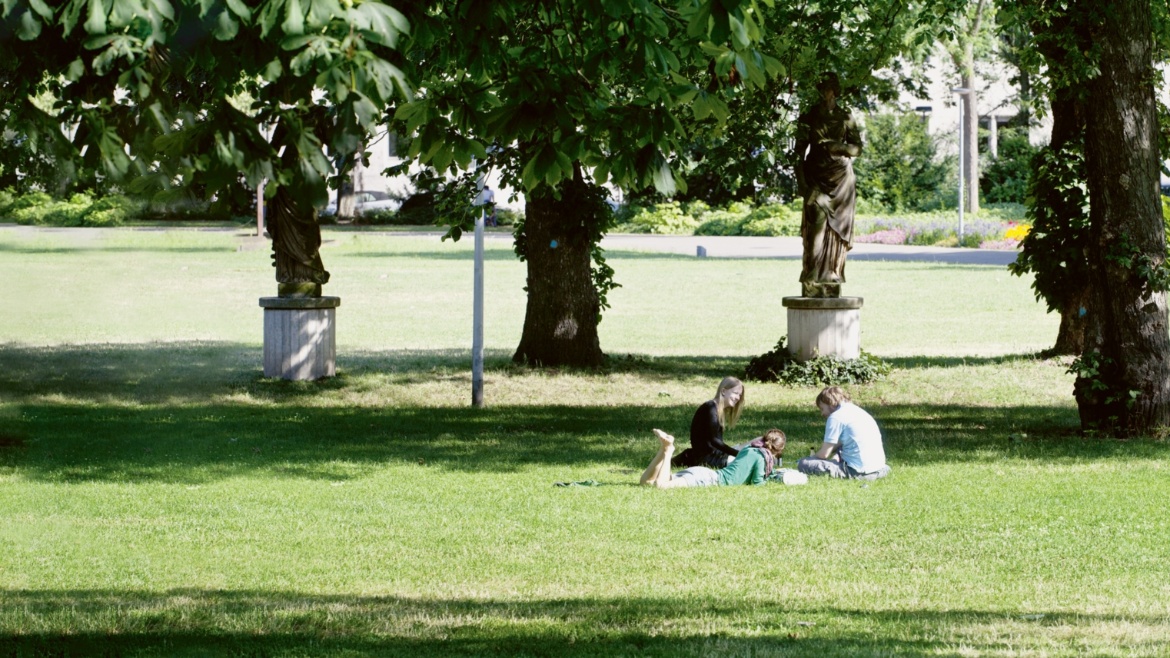
It's a typical day at the Stadtgarten right next to the University of Stuttgart: a student is gingerly making her way across a slackline; a chap is sitting on a park bench enjoying his lunch break; a pensioner is walking her dog across the lawn. In the midst of the urban hustle and bustle, the park is a place to relax and is a popular meeting place, especially for students. At the same time, it is a bit of a hidden treasure, because it is cut off from the surrounding city precincts by a number of multi-lane roads. And there are hardly any direct access points, despite the fact that it is only a ten-minute walk to Schlossplatz in the city center as well as to the main railway station. That might explain why the slackline course is popular with younger people, but many other things, such as the playground and sports facilities, are little used. Prof. Klaus Jan Philipp and Lena Engelfried from the University of Stuttgart's Institute of Architectural History are hoping to change that.
At the beginning of 2021, they founded the “Quartier Stadtgarten” initiative to kick-start the urban development in the area surrounding the Stadtgarten, which has been the subject of controversial discussions in the city council for many years. The park was originally established for the first Württemberg Garden Exhibition in 1870, and was redesigned between 1973 and 1975 after having been largely destroyed during the Second World War.

Initiating a discussion about the Stadtgarten park
Now, almost 50 years later, the team wants to encourage new approaches with their initiative. “People are clearly interested, but no one wants to pay the money,” Philipp explains. As a first step, he and Lena Engelfried wrote to all residents adjacent to the Stadtgarten, such as the hospital, various ministries, restaurants, and universities. One of the first things that the team did was to write a letter to the Lord Mayor of Stuttgart, Frank Nopper, in which they outlined their ideas for the future of the Stadtgarten. Since then, they have been in talks with numerous other people who are employed by the municipal authorities.
What we are motivated to do, is to reignite the debate around the Stadtgarten and to get things moving again.
Lena Engelfried
The idea of the initiative is to improve the Stadtgarten in time for the International Building Exhibition 2027 which will be held in the urban district of Stuttgart (IBA’27). “In the meantime, it will not be possible to build any new structures or make any major planning changes to the garden,” says Philipp. However, he does want people to at least see some difference by 2027. “What we are motivated to do,” says Engelfried, “is to reignite the debate around the Stadtgarten and to get things moving again. As well as connecting residents, this initiative will also ramp up the pressure to highlight the relevance of the issue. United, we will have a louder voice.”
Students are developing ideas for the new design
Alongside the “Quartier Stadtgarten” initiative, Engelfried and Johannes Nöldeke of the Institute for Social Sciences are offering a work placement semester in the interdisciplinary Public Planning and Participation master's program, which will not only support the initiative but will also give students some hands-on work experience. “The Stadtgarten is ideal for public participation because it involves an ongoing planning process with a public interest dimension,” says Nöldeke, “and it's also right on our doorstep, on the Stadtmitte Campus. “It's important to me to give students a chance to take ownership, make an impact, and ultimately to experience a sense of personal growth in the process.”
Students analyzed the initial situation and developed ideas for participation procedures in the winter semester of 2021/2022. One group, for example, is campaigning to make part of the Breitscheidstraße parking lot, which is near the university, car-free for a day, which they then want to repurpose as a multi-generational meeting point.
They are also planning to set up various benches made of pallets, each of which include a QR code, which will give people access to a number of surveys to find out how Stuttgart residents envision the Stadtgarten in the future. They will also be setting up a kind of living room with a sofa, bookshelves, and a ping-pong table.
Each piece of furniture will symbolize one of the garden's functions, such as relaxation, movement, and gastronomy, where visitors will be able to contribute their own ideas for each area. Another group plans to spray chalk footprints on the ground to highlight the networking potential of the park. The results of the seminar will eventually be presented during the City of Stuttgart's Science Festival, and may potentially provide a further impetus to revitalize the historic Stadtgarten.
Editor: Carina Lindig
Prof. Klaus Jan Philipp, Institute of Architectural History, University of Stuttgart
Mail
Phone: +49 711 685 83290



